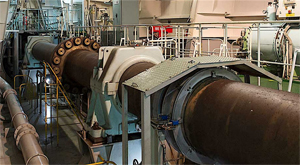Phase one of a new study by the classification society DNV GL has found that environmentally acceptable lubricants (EALs) are as safe as mineral oil-based lubricants for shaft bearing applications in most conditions, except when temperatures are low and oil-film pressure is high.
The study was prompted by an increasing number of stern-tube bearing failures after the Environmental Protection Agency (EPA) began regulating the use of mineral oils in “oil-to-sea interfaces” in late 2013. Affected vessels in U.S. waters are required to use environmentally acceptable lubricants that biodegrade.
Multiple factors can cause problems in stern tubes, but questions regarding the role of EALs in the failures prompted DNV GL to conduct the study to understand how EALs perform compared to traditional mineral oils. The first phase of the research focused on the viscosity of EALs and mineral oils when influenced by temperature, pressure and shear rate.
“While the new eco-lubricants perform well in most situations, there are extreme, transient load conditions where their pressure- and temperature-related viscosity properties are inferior to that of mineral oil equivalents, providing less protection against bearing failure,” DNV GL said. Instances where this was a factor in recent bearing failures were “hard maneuvering at high speeds (high pressure), mooring trials (low temperature and high pressure), and operating with a partly submerged propeller (high pressure).”
Based on these findings, DNV GL lubrication criteria specify a viscosity factor of .075 for non-mineral lubrication oils to maintain the required safety margins. This update is included in the July 2019 rule edition but is not retroactive for vessels operating under older applicable DNV GL rules. The classification society also recommends optimizing the aft stern-tube bearing layout to fit the propeller shaft “across a range of operating conditions.”
“Shaft alignment has always been important, but with the thinner operational fluid film of some EALs, it is even more critical,” said Phil Cumberlidge, business development manager for Panolin’s GreenMarine range of EALs. “But we are dealing with microns of film thickness here. Shipyards cannot really achieve that degree of alignment to compensate for those EALs that have a thinner oil film thickness.”
Shipowners are nervous when it comes to EALs, and they have every reason to be, Cumberlidge said.
“It is a costly process to dry-dock a vessel to scrape out stinking sludge, replace seals and replenish with fresh EALs,” he said.
Cumberlidge recommended that vessel owners investigate all types of EALs considered biodegradable, including fully synthetic saturated ester, non-emulsifying EALs. He also advised shipowners to ask lubricant vendors about any reported problems.
Others advocate for an entirely different solution. In a company letter to customers after DNV GL’s report, Craig Carter, director of marketing and customer service at Thordon Bearings, said he would not be surprised if classification societies “start to revise their shaft alignment and withdrawal rules for bearings using this kind of lubricant.”
“There is no doubt that lubricating white metal bearings with biodegradable oil can be technically and commercially risky,” he said. “With mineral oil-based lubricants now rightly regarded as environmentally unacceptable, the only proven EAL option available for lubricating the propeller shaft bearing is seawater.”
Regarding seawater as a lubricant, a DNV GL representative said during a webinar presenting the study findings that “open and closed water-lubricated solutions are a completely different design solution with different bearing materials than the oil-lubricated, white-metal bearing designs. Assessing the performance of seawater-lubricated systems would require different testing (than what is being done) as part of the EAL study.”
In the next two phases of the EAL study, DNV GL will assess oil-film forming capabilities, mixed/boundary lubrication behavior, and lubricant degradation (medium and long term).

